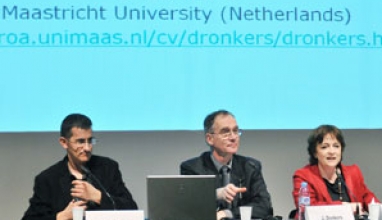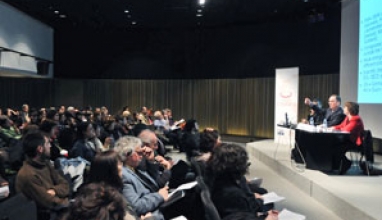You are here
The Influence of Origin and Destination Countries in Immigrant Pupils’ Performance
About the speaker
Jaap Dronkers
International Research Professor in Educational Performance and Social Inequality at the University of Maastricht
“The educational characteristics of the origin country are more important than those of the destination country” Object of research • Analyse performance at school of immigrant pupils, comparing the performance in the origin and destination country. • Study the effect of the educational systems in the origin and destination country on performance at school of immigrant pupils. • Analyse the effect of macro-characteristics in the origin and destination country (political, economic, religious, etc.) on progress at school of immigrant pupils. Data the study is based on • Data from the PISA 2006 study which analysed the educational skills of 15-year-old students in a series of subjects. The average score is 500. • Dronkers highlights the fact that analysis of immigrant students’ performance is not possible in many countries (such as Spain, France, or England) because the PISA study in these countries did not specify students’ origins nor the origins of their parents, meaning there are no variables for analysis. • The countries analysed were Australia, Austria, Belgium, Denmark, Finland, Germany, Greece, Liechtenstein, Lithuania, Luxembourg, Netherlands, New Zealand, Norway, Portugal, Scotland and Sweden. • The professor's study defines immigrant students as those born in a different country to that in which they study or those with parents born in another country. • The study was carried out on a sample of 9,414 immigrants from 46 different origin countries. Results by origin country • The immigrants with the lowest levels of performance are those from Cape Verde, followed by Albania and Pakistan. • Those with the highest levels of performance come from India, China and USA. Comparison of the native and immigrant pupils’ results • The results of natives are, in nearly all cases, better than those of the immigrants. This difference is greatest in countries such as Austria, Denmark and Germany. The exception can be seen in Australia, which is the only country where this trend is not seen. Analysis of Turkish pupils in their origin and destination country • Turks in their country of origin achieve better results than in the destination countries. They achieve their worst results in Austria and their best in Sweden. First-generation immigrants achieve lower scores than second-generation immigrants (except in Germany). • Immigration policies in the destination countries do not directly affect pupils’ results. For example, Belgium and Germany have had guest worker programmes for some time and immigrants do indeed achieve better results here than in Austria where the guest workers policy has been in place for less time. However, in Denmark, where there is no such policy, results are better than in Austria. • Nor does the religion of the Turks seem to be decisive because the results of the Turks do not differ from those of immigrants from other countries with different religions. Italian or German immigrants have the worst results when compared with the results in the country of origin. • Dronkers comes to an initial conclusion: results are worse if immigrants are “very visible”, if they do not look like pupils in the destination country (in Finland, immigrants achieve high scores, but usually come from similar countries like Sweden and Norway). Analysis based on the characteristics of the school system and the parents • The best results are achieved by immigrants in schools with a moderately differentiated system. The worst results are in comprehensive schools. • The level of education of the parents is always a factor. The lower the level of the parents, the lower the level of the children. • Children of those with a higher level of education achieve the best results in comprehensive schools. • Immigrants achieve worse results in educational systems with worse teacher ratios. • Results are also better if education in the countries of origin is compulsory to a later stage. This affects both first- and second-generation (who have not studied in the country of origin) immigrants. Analysis of the political, economic and religious aspects of the origin and destination countries • The results of immigrants in countries that have a tradition of receiving immigrants are not much better than in countries without this tradition. However, there is a difference when the socioeconomic level of the parents is high. Then there are better results in countries with a tradition of receiving immigrants. • Immigrants from countries with unstable political systems do not achieve worse results than those who come from other countries. • The economic status of the country of origin is not a decisive factor in the results. • Christian immigrants achieve better results than Muslims, but worse than those from Oriental religions. Dronkers explains that the perception of discrimination differs in terms of the religion. Faced with the same level of discrimination, Oriental immigrants are not affected, whereas Muslims and Christians are. Likewise, Islam establishes strong values that do not always resonate well with modern trends. Dronkers, however, does not see the disadvantages of religion as being eternal (for example, Catholics were at a disadvantage to Protestants in the 19th century, but this is no longer the case). Possible explanation for the good results for Oriental religions and, above all, Chinese students • The most generalised explanation, though not entirely true, is that the Chinese have a very authoritarian style of education in their origin country and that is why they achieve good results. But this does not prove why they should also achieve good results in the destination country where the education is not as authoritarian. • This is due, in part, to the importance given to education culturally as a key factor for social mobility. The Chinese value studying very highly. • He also mentioned the neuropsychological advantages arising from the study of highly complex graphic symbols. They learn some 3,000 from a very early age. And the fact that their number system is much clearer than ours. • Chinese immigrants who continue speaking Chinese at home (including second-generation immigrants) value education and time spent reading very highly. This appreciation is even higher than in their origin country. • Indeed, results in mathematics and reading for those second-generation Chinese immigrants living outside Asia who continue to speak Chinese are higher than in their origin country or of those who do not speak Chinese. FINAL CONCLUSIONS • The individual characteristics are more important than the macro-characteristics (both in the origin and destination countries). • The parents’ level of education affects their children’s learning. The higher the level of education of the parents, the better the results of the children. • The educational characteristics of the origin country are more important than those of the destination country. This influence affects second-generation immigrants, even though they have not been to school in the origin country. FINAL REFLECTIONS • Schools with very heterogeneous student bodies have to spend more time maintaining the equilibrium, which takes time away from purely educational issues. Dronkers notes (a possible topic for a future Debate) that educational policies may need to look to specialist schools for different types of immigrant. It has been proven that Muslim immigrants in Muslim schools achieve better results. But, is this separation socially acceptable?
Discover
other ideas
-

The State of Education in Catalonia. Priorities an...
Ferran Ferrer, Ramon Farré, Ramon Plandiura
2010 -

Decline of Schools and Conflicts of Principles
François Dubet
2010 -

Perennial Dilemmas Policymakers and Practitioners...
Larry Cuban
2010






























 The texts published on this website are, unless otherwise indicated, covered by the Creative Commons Spain Attribution - Non Commercial - No Derivs 3.0 licence. You may copy, distribute and transmit the work, provided you attribute it (authorship, journal name, publisher) in the manner specified by the author(s) or licensor(s). You may not use the material for commercial purposes. You may not transmit any derivative work from this material. The full text of the licence can be consulted here:
The texts published on this website are, unless otherwise indicated, covered by the Creative Commons Spain Attribution - Non Commercial - No Derivs 3.0 licence. You may copy, distribute and transmit the work, provided you attribute it (authorship, journal name, publisher) in the manner specified by the author(s) or licensor(s). You may not use the material for commercial purposes. You may not transmit any derivative work from this material. The full text of the licence can be consulted here: